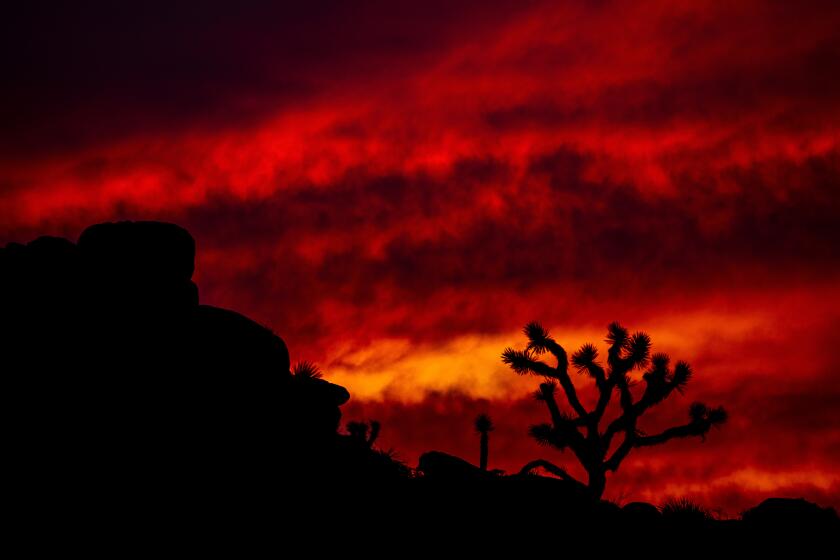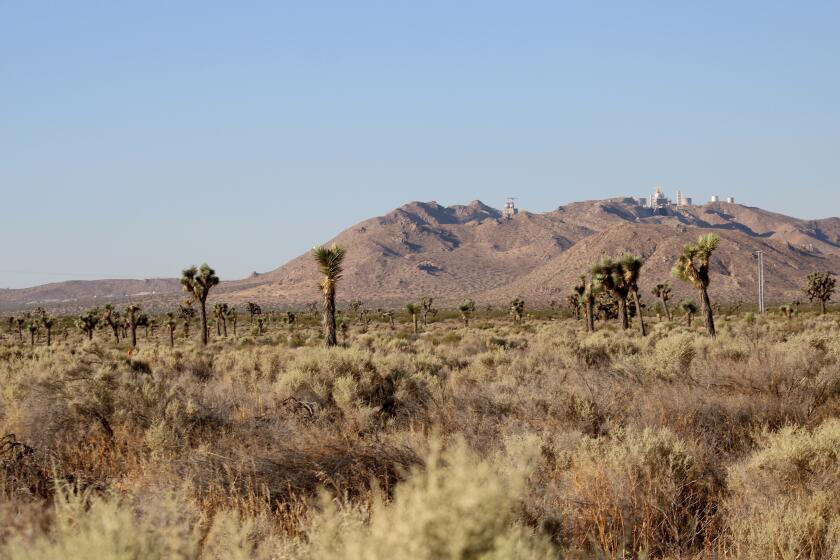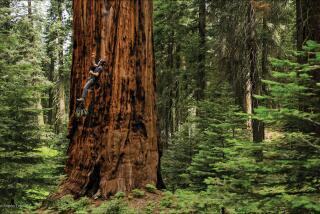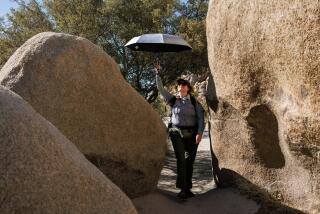
- Share via
- A sweeping new conservation plan aims to ensure the survival of the Western Joshua tree
- The iconic species faces habitat loss from climate change, wildfires and development
The Joshua tree is cherished for its distinctive silhouette and singular role as a linchpin of the Mojave Desert ecosystem. Yet the iconic succulent is losing suitable habitat at a brisk clip due to climate change, worsening wildfires and development, scientists and environmental advocates say.
A new plan by the California Department of Fish and Wildlife to ensure the Joshua tree’s survival calls for limiting development in certain areas, including those where the plant may be able to thrive in a future anticipated to be warmer and drier, even as other portions of its range become uninhabitable.
The draft plan also calls on government agencies to develop strategies to mitigate and fight wildfires that threaten Joshua trees.
“It’s groundbreaking in that it’s really the most comprehensive attempt done by the state of California or really any entity I’m aware of in the United States on how to manage a species that’s clearly threatened by climate change,” said Brendan Cummings, conservation director of the Center for Biological Diversity.
The nonprofit petitioned to list the western Joshua tree as threatened under the state Endangered Species Act in 2019.
The plan does not spell out exactly how much land should be prioritized for protection, or where it is. But it lists criteria for ranking its conservation value, like having a high density of healthy Joshua trees and existing within an area where conditions are cooler and wetter than much of the rest of the range. It sets a goal of identifying priority conservation areas by December 2025, and protecting 70% of these areas by 2033.
The plan also recommends introducing Joshua tree populations with genetic variations that make them more resilient to climate change into these areas, said Drew Kaiser, senior environmental scientist at the Department of Fish and Wildlife. That strategy, called assisted gene flow, can be accomplished by planting seeds or seedlings, or by relocating mature trees, he said.
Much of the western Joshua tree’s range is federal land, so the state will have to work across jurisdictions to effectively protect it, Kaiser said. Multiple federal agencies have shown interest in establishing conservation agreements under which they’d adopt the management actions suggested in the plan, which also include minimizing harms from wildfire, grazing, offroading and pesticide use, he said.
Cummings said the effectiveness of the plan will depend on how it’s implemented.
To that end, a new coalition of nonprofits and government agencies has formed to foster collaboration among the many researchers, land managers and tribes working to conserve Joshua trees, with the help of $1.4 million in seed money from California’s Wildlife Conservation Board. The coalition will be instrumental in carrying out the plan’s goals, Kaiser said.
More than a third of the western species’ range in California is private land and includes some of the fastest-growing communities in the region, Kaiser said. Large-scale renewable energy projects have bulldozed thousands of Joshua trees at a time.
“The Joshua tree is widespread and abundant now, but you have all these pressures with development, with wildfire and then, on top of that, climate change,” Kaiser said. “That really is a death-by-a-thousand-cuts kind of situation.”
The conservation plan was mandated by a law that enacted last year after the California Fish and Game Commission deadlocked on whether to declare the species threatened. The Western Joshua Tree Conservation Act also requires developers to obtain permits and pay fees to kill, damage or remove Joshua trees. That money is earmarked for a conservation fund to purchase and conserve suitable habitat.
The law drew criticism from some high desert politicians, who feared it would drive up the cost of living in some of the last affordable regions in Southern California.
Both the conservation act and the potential listing under the state endangered species act were opposed by the San Bernardino County Board of Supervisors, whose representatives said either move would discourage economic investment in Mojave Desert communities.
In a letter sent last year to the state Senate and Assembly budget committees, Supervisor Dawn Rowe pointed out that there are tens of millions of western Joshua trees over a range of roughly 5,300 square miles and said the species “is abundant, widespread, and is in no danger of extinction.” State biologists had also recommended against designating the western Joshua tree as threatened, saying concerns about the effects of climate change were premature.
Assemblyman Tom Lackey (R-Palmdale) grew up in the desert town of Boron and appreciates Joshua trees as “part of the culture of desert existence,” he said.
But he thinks the conservation law goes too far in the fees it imposes on developers.
“For our communities to survive, we have to figure out a way to balance environmental stewardship with economic development,” he said, recalling a recent project in which a Lancaster high school sought to build new athletic facilities and learned the cost would increase by $200,000 due to the removal of Joshua trees on-site.
“It seems like the Joshua tree has become somewhat of an ATM for government officials,” he said.
Even though the Joshua tree is currently ubiquitous, climate models clearly show there won’t be much suitable habitat left by the end of the century, Kaiser said. The conservation plan states that just 23.4% of the western Joshua tree’s range in California falls into the category of predicted climate refugia — places where the species will be able to continue to survive as conditions get hotter and drier — and that’s under a modeling scenario in which carbon emissions remain lower than many expect.
Many of these cooler, higher-elevation areas that are expected to have the most hospitable climate are also susceptible to wildfires because they tend to have denser vegetation, he added. Two large wildfires have killed an estimated 1.8 million Joshua trees in and around the Mojave National Preserve since 2020.
Kelly Herbinson, executive director of the Mojave Desert Land Trust, said the idea for the Joshua tree coalition was inspired by the Giant Sequoia Lands Coalition, which was similarly born out of concern for a tree that serves as the namesake of a national park and is under threat from climate change and habitat loss.
“We won’t be able to protect them once there’s few of them left — we have to be thinking about it from a proactive approach,” she said.
The conservation nonprofit convened the coalition, which includes representatives from the Native American Land Conservancy, California Department of Fish and Wildlife, National Park Service and other federal agencies.
As Joshua trees struggle with climate change, habitat loss and increasingly intense wildfires, California is scrambling to complete a conservation plan.
California’s Wildlife Conservation Board provided $1.4 million in seed funding to build the coalition and launch a massive statewide monitoring effort led by scientists at the U.S. Geological Survey. Dozens of biologists will fan out across the western Joshua tree’s range and take measurements from each population to assess how the plants are doing, with the goal of returning every seven years to measure changes over time. They expect to start early next year and have results wrapped up in late 2026, Herbinson said.
The coalition partners plan to work on strategic land protection by identifying climate refugia and protecting those areas from development.
The Native American Land Conservancy will ensure the many Indigenous groups on whose ancestral land Joshua trees grow will have a seat at the table, said Elizabeth Paige, education and stewardship program manager of the nonprofit and a member of the Torres Martinez Band of Desert Cahuilla Indians.
“We hold thousands of years of hypotheses being tested and knowledge being bestowed from generation to generation — that’s how we learn history,” she said. “It’s a whole other level of holistic care of the environment.”
Mojave town protests solar energy project as crews chainsaw hundreds of protected Joshua trees
Joshua trees are two distinct species — eastern and western — that grow in California, Arizona, Nevada, Utah and Mexico. Across most of their range, they’re one of the few tall plants that provide shade and shelter.
Dozens of animals rely on them to survive. An estimated 25 bird species, including ladder-backed woodpeckers, loggerhead shrikes and western screech owls, nest in their trunks and branches. Desert night lizards sleep and forage beneath their fallen boughs. Yucca moth caterpillars, kangaroo rats and ground squirrels eat their seeds.









